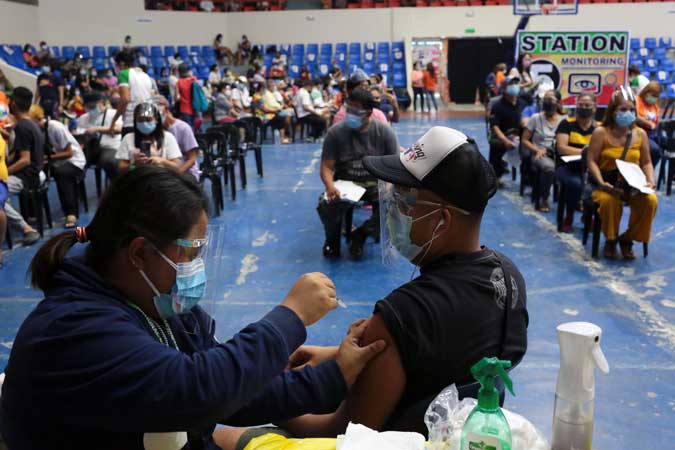Economic team may rethink stimulus

By Luz Wendy T. Noble, Reporter
ECONOMIC MANAGERS now appear to be open to considering a third stimulus package that could help improve the Philippines’ recovery prospects, after Fitch Ratings gave a “negative” outlook on its credit rating.
“The Development Budget Coordination Committee (DBCC) will be meeting [this Monday]. We’ll see what’s going to shape up,” Budget Secretary Wendel A. Avisado said in a Viber message to BusinessWorld.
Mr. Avisado said discussions on Bayanihan III could be a part of the DBCC’s agenda.
The House of Representatives has already approved a third stimulus package worth P401 billion. House Bill 9411 or the Bayanihan to Arise as One Act (Bayanihan III) could be the largest of the Bayanihan series of stimulus packages if passed by Congress.
However, its counterpart measure remains pending at the Senate committee level.
Socioeconomic Planning Secretary Karl Kendrick T. Chua said there are some provisions under Bayanihan III that may be considered if there are extra funds available.
“There are some items [from the measure] that we can pursue if we have savings or additional revenues,” Mr. Chua said in a Viber message.
For Marikina Rep. Stella Luz A. Quimbo, the passage of a third stimulus measure may convince credit raters that the Philippines could weather the impact of the pandemic through “well-targeted spending” that will help businesses and individuals.
“High impact government spending will be key to boosting our economy’s trajectory of growth and improving our long-term prospects. Bayanihan III lays out a spending plan to help ensure that public funds are well-targeted and used productively,” Ms. Quimbo, one of the main proponents of Bayanihan III, said in a Viber message.
Fitch Ratings last week revised the Philippines’ outlook to “negative” from “stable,” saying this reflects “increasing risks to the credit profile from the impact of the pandemic and its aftermath on policy-making as well as on economic and fiscal out-turns.”
While Fitch maintained the Philippines’ “BBB” investment grade sovereign rating, a “negative” outlook is a warning that this rating could be downgraded in the next 12 to 18 months.
“Fitch will monitor the evolution of the fiscal deficit and debt levels, as the balance between fiscal consolidation and ongoing government spending to support economic recovery will be an important consideration for the rating,” the credit rater said.
Bangko Sentral ng Pilipinas Governor Benjamin E. Diokno, however, said he does not believe Bayanihan III can lift the country’s rating outlook.
“I disagree, however, that legislating Bayanihan III will help us to improve our ratings prospects after Fitch downgraded the country’s outlook to ‘negative’ from ‘stable.’ Nevertheless, it should be pointed out that in a sea of ratings downgrade globally last year and this year, Fitch has affirmed the Philippines’ investment grade…That should be seen in a positive light,” he told BusinessWorld in a Viber message.
Mr. Diokno, a former Budget secretary, said what will be crucial is for the government to accelerate the vaccination drive, continue structural reforms, and aggressively pursue infrastructure projects.
“These measures will immensely improve the Philippines’ growth prospects and its ability to attract foreign direct investments,” he said.
“The rationale for Bayanihan III fades with the submission of next year’s President’s Budget with a month or so.”
The Department of Budget and Management earlier said it is proposing a P5-trillion national budget which will focus on vaccination rollout and increased support for local governments, among others.
With the implementation of the Mandanas ruling next year, Mr. Diokno said more fiscal resources will go to local government units (LGUs).
“LGUs may be in a better position to address the needs of their local constituents who are affected by the pandemic. If local officials don’t want to overburden their fiscal position as a result of high incidence of COVID-19 in their community, then they should exert more effort to contain the virus through strict enforcement of health protocol and more aggressive contact tracing. This is what we call ‘incentive compatible,’” he added.
Lawmakers have been pushing for another stimulus package, even before the Bayanihan II expired in June.
“In the past year, the absence of a sufficiently sized economic stimulus package contributed more to the contraction of the economy and reduction in tax collection than prudent management of our debt,” Ms. Quimbo said.
Bank of the Philippine Islands Lead Economist Emilio S. Neri, Jr. said the country “appeared to have sacrificed so much” to maintain its investment grade credit rating through fiscal prudence at the expense of being unable to spend more for economic recovery.
“The decision to choose the austerity path appears to have had a bigger effect on the decline in our nominal GDP (denominator) than the increase in our public debt (numerator) translating to our debt/GDP ratio to exhibit the fastest deterioration in Southeast Asia versus 2019 levels,” Mr. Neri said in a Viber message.
The Philippine debt-to-GDP ratio stood at a record low of 39.6% as of end-2019. Since the pandemic, the ratio has climbed up to 60.4% as of end-March 2021.
Against the backdrop of rising debt level, the economy shrank by a record 9.6% in 2020 which was the worst in Southeast Asia. The Philippines remains in a recession, with GDP shrinking by 4.2% in the first quarter.
Fiscal support coming from Bayanihan I and II was equivalent to 4.4% of the country’s GDP in 2020, based on the International Monetary Fund’s policy tracker as of July 1. Other measures including credit guarantees made up 0.6% of 2020 GDP.
“Sustaining reforms such as plugging leakages in our tax system and lifting bank secrecy rules are also necessary to improve revenues and not have to rely mostly on austerity, debt monetization and negative real policy rates to keep our public sector deficits manageable,” Mr. Neri said.
In May, S&P Global Ratings retained its “BBB+” rating with a “stable” outlook for the Philippines, citing expectations of economic recovery.
Moody’s Investors Service kept its “Baa2” rating with a “stable” outlook for the Philippines in July 2020. In March 2021, Moody’s said the renewed COVID-19 surge was “credit negative” for the country.



